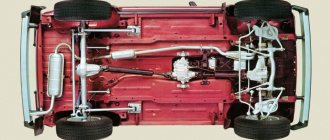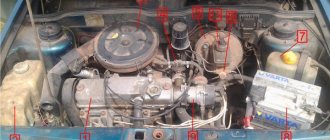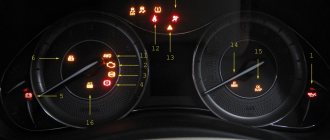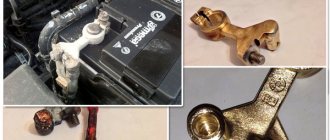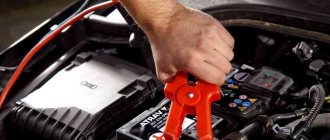The car engine is overheating.
Overheating of a car engine is a problem that every driver can face. In this article we can learn: - how to notice in time that the engine has overheated; — why the engine heats up in general and in certain situations; — what to do if the engine overheats.
To understand the essence of the issue, it is necessary to consistently read all the explanations of an experienced auto mechanic.
How to determine if the engine is overheated
At first glance it seems very simple - according to the indicators of the engine temperature device, or - sensor. This is true, if not for one thing - novice motorists are so captivated by the road situation around them that they look at the instrument panel only in one case - how much fuel is left. Experienced motorists, on the contrary, due to their confidence in their abilities, also do not look at the car’s dashboard. And as a result, a situation often arises that overheating is detected when the engine temperature has long exceeded permissible limits, and irreparable damage has been caused to the engine. It is irreparable overheating that is one of the most complex malfunctions, which leads to very serious consequences. But more on that later. But there is a way that will not let you miss the moment of overheating. This is problematic in a traffic jam, and is not always clearly present, but here’s what you should be aware of:
— As soon as the engine temperature exceeds the permissible norm, when you sharply press the gas pedal, or when accelerating the car, even slightly, detonation knocks are clearly heard , which are popularly called “tapping fingers.” This is not true, but everyone knows this definition. If you hear such a sound, there is a 99% chance that the engine has overheated, and action must be taken.
Detonation knock is a loud metallic knock, the frequency of which coincides with the engine speed. You've probably heard such sounds when refueling with low-quality fuel. I personally don’t know where the concept of “tapping fingers” came from. But the real reason for such knocking noises is a disruption in the fuel combustion process. What you hear is nothing more than explosions of the fuel mixture. During normal engine operation, the combustion process is controlled, but as soon as one of the operating parameters is violated, the process goes out of control and combustion turns into an explosion. Hence the concept - detonation (from the word detonate - explode) knocks. When the engine overheats, this is the first sign.
Before continuing the conversation, let's define what is normal temperature and what is overheating. There is no one-word answer, but there are general rules. The engine temperature is within 85-95 degrees Celsius, which is working. Engine temperature up to 100 degrees is acceptable. This means that a short-term increase in temperature to 100, sometimes up to 105 degrees is allowed. Just for a short time - up to 5 minutes. Engine temperature above 105 degrees Celsius means overheating and action must be taken.
Sensor check
VAZ 21093 coolant temperature sensor
There are two ways to check. To check the temperature sensor in the first way, you should:
- Connect the negative end of the voltmeter to the engine.
- Turn on the ignition.
- Using a voltmeter, determine what voltage is generated while driving a car.
- It is important that this voltage is at least 12 V (with a charged battery).
Note: otherwise you will have to either repair or replace the sensor with a new one.
VAZ 21093 coolant sensor
The second verification method is more reliable. To implement it you need:
- Set the multimeter to voltmeter mode. The voltage should be measured in the range from 100 Ohms to 10 kOhms.
- Take a thermometer that can change the temperature up to 100 degrees and above.
- Place the sensor in a container with coolant.
- Warm it up. In this case, you should constantly monitor the temperature, which a thermometer will help with.
- Measure the resistance of the sensor at different temperatures.
Note: This method can be slightly modified. Pour boiling water into the container and immerse only the working part of the sensor in it. Monitor the resistance of the sensor as the water cools.
Reasons that can cause overheating
1. Lack of coolant. The liquid in the engine boils not because there is not enough of it, but here’s why: remember about the outer surface for cooling? If there is a lack of fluid, the contact surface between the fluid and the heated engine is insufficient, and heat transfer to the environment is poor. This is where the overheating comes from. The engine cooling system is not sealed, as many believe, and fluid evaporates during operation - do not forget to check its level regularly. And of course, monitor the condition of the radiator and pipes - leaks are unacceptable. There are cases of internal leakage - as a result of damage to the gasket between the head and the cylinder block. Water will not flow out of the exhaust pipe, but a constant decrease in the fluid level without visible leaks is a reason to be wary and contact a specialist. Water accumulated in the cylinders at the moment of starting the engine can lead to water hammer - this can literally destroy the piston group, and not only that.
2. Radiator condition. The gaps between the radiator honeycombs are quite small and can gradually become contaminated by representatives of the insect world. This is not a joke; there was a case when minor contamination of the radiator (coupled with the poor condition of the engine) led to constant overheating of the car. Keep the radiator clean and blow it with compressed air at least occasionally.
3. Incorrectly set ignition angle. If the ignition angle is violated, the fuel combustion process is disrupted. As a consequence, an increase in combustion temperature and a decrease in power. The power has dropped, but there is no need. What are we doing? That's right - press the gas pedal harder. It turns out that more fuel is spent on the design operating mode of the engine (at which normal cooling occurs). Hence the overheating. By the way, an ignition problem can arise (spontaneously, and not after your intervention in the finely tuned engine mechanism) if the timing belt or chain is stretched. This is not the only possibility, but it is common - keep in mind.
4. Fuel quality. An inappropriate octane number leads to a decrease in power and an increase in the temperature of fuel combustion. There is only one way out - refuel in one place, so the likelihood of getting bad gasoline is lower.
5. Deposits on the walls of the engine and radiator. The reason is simple - the use of low-quality coolant, or even water. A little more detail. From a physics point of view, using water is better, since water has better thermal conductivity than alcohol-containing antifreeze. But - there are salts in the water (you can see them on the walls of the kettle) - the same thing happens inside the engine. As a result, water circulation is disrupted, cooling efficiency is reduced and the engine overheats. If you are pouring water into the expansion tank, pour distilled water, it is free of salts. It is best to use special antifreeze. Believe me, it is impossible to completely remove scale from the engine. And one more “beauty of water: if, after water, for example in winter, you fill in antifreeze - be prepared for drips (it can leak anywhere: radiator, pipes) - this is a fact. If you constantly drive “on antifreeze,” nothing will happen, but after water, antifreeze will flow 99%.
6. Engine wear. This can include many aspects, but in most cases it is wear of the piston group. During long-term use of the car, the piston rings, which serve to seal the combustion chamber, wear out, which leads to a decrease in compression, impaired fuel combustion, loss of power (remember the formula) and overheating of the car.
Somehow it turned out to be too difficult. To put it simply: fuel burns better at a certain pressure that is created in the combustion chamber. Pressure is about 12 atmospheres. If you take a pipe, plug it with potatoes and blow inside, pressure will be created inside, which is called compression. The force with which you blow will represent the force of expansion of the fuel during combustion, which pushes on the piston and causes the crankshaft to rotate. The rings serve to fit the piston more tightly to the cylinder (in our case, potatoes and tube). Now, if you put in a loose piece of potato and blow, the air will pass past the potato piston.
This is what happens in the engine when the piston group wears out (ring wear and cylinder wall wear). As a result, part of the expansion energy of the fuel during combustion passes by the piston (between the piston and the cylinder), and compression (optimal pressure in the combustion chamber) decreases, which worsens the quality of combustion. And again - loss of power and overheating. There is only one way out - contact a specialist.
Main causes of overheating
The classic cooling scheme consists of a large and small circuit through which antifreeze circulates. The thermostat performs a regulatory function, directing the liquid in the desired circle. It is cooled in a radiator made of aluminum. The fan built into the system turns on while the car is running at low speeds, helping to maintain the required degrees.
When the engine of a VAZ 2110 gets hot, the reason lies in the following malfunctions:
- The thermostat is malfunctioning;
- the fan has failed;
- an air lock has formed in the cooling system;
- insufficient coolant level;
- antifreeze boiling;
- dirty engine.
Each of these reasons can become the main reason why the VAZ 2110 engine begins to overheat. As a result, the car loses power.
Thermostat malfunction
If the VAZ 2110 8-valve injector heats up, the reason may lie in a faulty thermostat. The unit is jamming. As a result, the circulation of liquid stops at any temperature. Often such a breakdown is caused by the fact that the VAZ 2110 car heats up for a long time at idle. The time of such warming up should not exceed 10 minutes. It is allowed to drive the car immediately after turning it on, provided that the first few km it is given a gentle mode.
Thermostat: 1-bypass valve; 2-outlet pipe (to the pump); 3-main valve spring; 4-main valve; 5-piston holder; 6-piston; 7-inlet pipe (from the radiator); 8-rubber insert; 9-solid heat-sensitive filler; 10-bypass valve spring; 11-inlet pipe (from the engine).
The thermostat can be checked directly on the engine. The operating procedure is as follows:
- The engine starts.
- The instrument needle begins to move upward.
- The radiator pipes located under the hood, top and bottom are checked. If the lower one becomes warm before the gauge needle starts moving, it means the thermostat is stuck in the open position. When it is permanently closed, the bottom pipe remains cold at any temperature.
You can also check the thermostat by dismantling it and understand why the VAZ 2110 8 valve engine heats up . To do this, the device is removed from the engine and placed in a container of water. This could be any saucepan that is placed on the fire. After the liquid boils, the valve should open. If this does not happen, then the unit is jammed. It cannot be repaired. It needs to be replaced.
Fan problem
If the VAZ 2110 8-valve injector heats up, the reason may lie in a non-working fan. This is a car component whose function is to cool the liquid in the radiator. The signal to turn on the electric motor is supplied by the sensor. This happens when the temperature exceeds the permissible threshold.
If the fan fails, then the VAZ 2110 with an injector begins to heat up for the following reasons:
- The thermostat valve is stuck. The coolant will constantly circulate only in a small circle, without entering a large one. Antifreeze will stop flowing into the radiator and will not reach the temperature sensor. As a result, the antifreeze will begin to boil.
- When the VAZ 2110 engine starts to heat up quickly, the reason may lie in a faulty fan drive itself. For testing purposes, it is connected directly to the battery. If it does not turn on, it means the drive needs repair.
- Before you start checking the drive, you need to inspect the fuse. His brand is F-7. The operation of the element is checked with a multimeter. The burnt out part is replaced with a new one.
- Fan relay failure. To get to it, you need to remove the center console cover in the installation compartment. The cooling relay is located on the left edge. It can only be checked by installing a new element. Then the VAZ engine warms up and the new part is monitored.
- A wiring break causes the fan to turn off. The break point is located using a tester. A new wire is being laid in this area.
Air lock in the cooling system
When antifreeze boils in the expansion tank of a VAZ 2110, the reason may be an air lock.
VAZ-2110 engine cooling system (with carburetor): 1 — heater radiator; 2 — steam removal hose of the heater radiator; 3 — outlet hose; 4 — supply hose; 5 — coolant temperature sensor (in the block head); 6 — pump supply pipe hose; 7 — thermostat; 8 — filling hose; 9 — expansion tank plug; 10 — coolant level indicator sensor; 11 — expansion tank; 12 — exhaust pipe; 13 — liquid chamber of the carburetor starting device; 14 — radiator outlet hose; 15 — radiator supply hose; 16 — radiator steam hose; 17- left radiator tank; 18 — sensor for turning on the electric fan; 19 — fan electric motor; 20 — electric fan impeller; 21 — right radiator tank; 22 - drain plug; 23 — electric fan casing; 24 — timing belt; 25 — coolant pump impeller; 26 — supply pipe of the coolant pump; 27 — supply hose to the liquid chamber of the carburetor starter; 28 - outlet hose.
It appears under the following circumstances:
- the coolant was replaced in violation of the technology;
- in case of engine overheating;
- when the system is depressurized.
To eliminate the reason why the VAZ 2110 engine heats up, you need to remove the plug from the system.
This is done in several ways:
- The expansion tank cap opens. We are looking for two hoses that go to the radiator. They are placed at different heights. Press them sharply to remove air. The cover is put in place and the car starts.
- The car is placed on a hill. The front of the car looks up. The steeper the slope, the better. The engine starts and 2-3 minutes. runs at idle speed. If this does not bring results, then the procedure is repeated. In this case, you should make several gas changes. After this, antifreeze is filled to the required level.
- The most effective method for removing the plug is to disconnect the fluid drain hose. To do this, loosen the clamp and remove the hose from the fitting. If the liquid does not flow, it means there is a plug. After this, antifreeze begins to pour into the tank. This is done until it appears in the hole in the hose. If this does not happen, the engine starts and liquid is expected to appear. As soon as it runs, this indicates that the air lock has been eliminated.
Insufficient coolant level
The reason why the VAZ 2110 8-valve injector heats up is often an insufficient level of antifreeze in the barrel. This happens due to fluid leakage. The reasons are the wear of the rubber pipes in the system. Despite the stability of the material, it loses its properties over time. Antifreeze begins to leak through the cracks. A decrease in liquid level causes an increase in temperature. As a result, the antifreeze in the VAZ 2110 boils and splashes out of the expander plug.
Sometimes the problem lies in the tank itself. Its production is not always carried out in accordance with technology. If the walls are thin, then there is a possibility of cracks forming on the surface. Sometimes the reason lies in a poor-quality plug. Chips on the threaded part create a leaky connection.
Antifreeze boiling
If antifreeze boils in the expansion tank of a VAZ 2110, the reasons may be as follows:
- The fluid enters through the head gasket. Traces of antifreeze are clearly visible on the oil dipstick. You can also smell gases from the expansion tank. The gasket needs to be changed urgently.
- Poor quality antifreeze. Dilution of the concentrate with water should only be carried out by the manufacturer. Adding on your own may result in incorrect concentrations.
- Loss of antifreeze properties. This happens after 2 years of using antifreeze. It becomes oily and changes color. The fluid must be replaced.
Dirty engine
If the VAZ 2110 8-valve injector is boiling, then the cause is a dirty engine. After a long mileage, a film of oils forms on the metal. When the car moves, dust gets under the hood, which, together with the oil film, forms a dense layer. As a result, blowing air onto the engine does not produce results.
To solve this problem: you need to keep the engine clean. All connections are constantly checked and, if necessary, sealed. Often the radiator becomes clogged with dirt and stops passing air. At times it needs cleaning.
If the engine in a VAZ car starts to heat up, you should know that there are main causes of the malfunction. During sudden heating, the thermostat valve may have jammed. When such a problem exists for a long time, the fault must be looked for in the system itself. This may be due to contamination, an air lock, or a problem with low-quality antifreeze.
What to do if your car overheats in a traffic jam
When driving a car for a long time in a lower gear, the engine operates with increased power, which in itself leads to overheating. Add to this the lack of counter-flow of air necessary to cool the radiator. What to do? The main thing is not to panic. Short-term overheating is not terrible, but if you see that the car is not cooling down, it’s time to act.
Important - do not turn off the engine unless absolutely necessary. Exactly - without extreme. A stalled, overheated engine is an almost 100% guarantee of repair. It will take quite a long time to describe what is happening in the engine in this case (rotating the liners together with the crankshaft, when the engine is subsequently started - the least of the possible troubles), just take it on faith.
Important - do not think about pouring water on the engine or pouring cold water into the radiator. The result is the same - repair. Moreover, you can try so hard that you cannot do without replacing the block and cylinder head. Another “beauty” of cold water is microcracks inside the block. Finding and eliminating will be very, very difficult, if not impossible. The car has overheated - try to pull over to the side of the road. If it doesn’t work out, don’t panic and don’t pay attention to those around you – it’s important for you to save the engine. Stop at idle, turn the heater on full, and wait. If after 5-10 minutes the situation does not improve, turn off the engine. It’s a good idea to open the hood; the main thing in a panic is not to forget to set the car’s parking brake.
The only reason to turn off the engine right away is clouds of steam coming from under the hood. Most likely, the cooling pipe has burst, and further operation of the engine will only worsen the situation.
This is what it looks like, engine overheating, if you look closely. Now you know why the engine gets hot and how to deal with it. Author: Igor
The problem of engine overheating is well known to many owners of domestic cars. The VAZ 2110 (2111, 2112) and 2113 (2114, 2115) lines were equipped with small-volume cooling radiators, so when driving for a long time in hot summer weather, the VAZ “normally” heats up to 105-108 degrees. But if the temperature goes through the roof even after a short trip, this is a reason to think about problems with the cooling system.
A high operating temperature of the engine may also indicate serious malfunctions. But in most cases, the VAZ 2114 heats up for minor reasons, including:
- thermostat malfunction;
- malfunction of the coolant temperature sensor (DTOZH);
- malfunction of the high pressure valve in the coolant tank cap;
- clogged radiator.
Insufficient coolant
Do you remember for sure that yesterday the refrigerant level was normal, but today in your VAZ-2114 the engine is heating up and the expansion tank is empty? This means that the tightness of the system was broken. And it’s good if only outside the engine. The worst thing in this case is the burnout of the cylinder head gasket. This malfunction is insidious in that liquid from the channels of the cooling jacket can get inside the cylinders, as well as into the oil channels.
More often, coolant leaves the system through the connections between hoses and radiator pipes (cooling and heater), thermostat, expansion tank, and engine. If the engine of a VAZ-2114 heats up and a coolant leak is obvious, check these places first! This problem is solved by tightening the clamps and adding fluid to the cooling system.
Next, inspect the hoses themselves. Often they simply crack over time, and antifreeze or antifreeze, being under pressure, flows out of the system. Such a malfunction can be eliminated by replacing one or another hose.
Thermostat malfunction
The thermostat is one of the weak points of the VAZ. It can be found on the right side of the cylinder block when facing the vehicle. To check the thermostat, you need to warm up the car until the fan turns on and touch the lower radiator hose with your hand. If the thermostat is working properly, it should be warm.
Removing the thermostat on a VAZ 2114
A cold pipe indicates that the thermostat is stuck in the closed position. In this case, the coolant circulates around the radiator, in a small circle. Heat exchange is disrupted - the engine quickly overheats. The problem is solved by replacing the thermostat.
VAZ 2114 heats up at idle
Help Friends! car VAZ-2114 1.6 8kl, the problem is that the engine heats up, the fan reaches the red mark and turns on, I wouldn’t pay attention, but it even heats up on the highway if the speed is up to 100 km/h then the temperature stays slightly above 90, and if more than 100 km/h, then the temperature also rises) changing the thermostat did not help). Why does the engine on a VAZ 2114 8-valve injector get hot?
Similar articles
15 comments on “Why does the engine of a VAZ 2114 8-valve injector get hot? The problem is that the engine gets hot"
The thermostat, or the pump, or the radiator is clogged, or there is an air lock, or there is not enough coolant
I had the same problem on 2115. I changed the thermostat, cleaned the radiator, but the whole problem was in the pump!
if the lower pipe is cold, the thermostat. But most likely the pump
change the pump and the fan should work near the red one
There is a temperature sensor on the radiator. change it. just buy 82 degrees. If it doesn't help, look at the pump.
Alexander, the author has an injector, but injectors do not have a sensor on the radiator.
change the fan switch sensor
looks like a pump except that the coolant level is normal and there are no leaks in the system
JOY at first for diagnostics I had such a bullshit arrow asshole
Thermostat. the valve does not open, it happened on 12 16kl, I changed it and forgot
Look at the pipes suitable for the radiator, they should be the same temperature if the 100 poods of term piseu are different
go for diagnostics, if the sensors show normal (you need to look carefully, otherwise I had experience with freaks who didn’t take money for anything), then the problem is mechanical
if there is a bc there the temperature of the fan is adjusted
I had something similar to the speed in the summer, the temperature was a little over 90 and as soon as you stop, the fan turns on and doesn’t cool much, it just doesn’t let you rise higher, when you start it cools down and it’s fine, so I changed the thermostat pump and the fan switch sensor, the thermostat sometimes opened, sometimes it didn’t, at the pump the lionfish moved on the shaft and it was already pumping weakly
The thermostat was changed, the water pump is also new and also ok
After buying the car, I noticed that at idle the engine heats up very quickly and, having passed 90 degrees, it also continues to increase until the propeller turns on (about 115 degrees). When driving, everything is fine, it maintains a stable 90, when you get up at a traffic light or in a traffic jam, everything starts to rise.
I changed the thermostat and completely replaced the antifreeze with a new one (when I bought it, it was filled with water or something like that, an incomprehensible thing) But the problem still remained.
I read the forums, they say this is normal. But for some reason I don’t think so...
The VAZ fourteenth model is one of the most popular models on the domestic automotive market. The popularity of the machine is due to its unpretentiousness in maintenance and simplicity of structural elements. The main disadvantage of this car is overheating of its engine, especially in the warm season. This article will help you figure out what this is connected with.
Radiator clogged
The radiator can be clogged from the outside and inside. External contamination is associated with dust and other debris, as well as insects, entering the honeycombs. This worsens heat transfer and is manifested by frequent operation of the fan and a long operating time.
Clogged engine radiator honeycomb
A good high pressure washer solves the problem. If the radiator has been in use for a long time, the car cools and heats up worse due to deformation of the honeycombs. You can “cure” this problem by replacing the radiator.
Dashboard malfunction
The cause of incorrect readings on the dashboard may be a factory defect or a huge number of electrical faults: from a bad ground on the ECU to a failure of the voltage stabilizer (“tablet”). This can be indicated by uneven changes in temperature readings (jumps), incorrect readings of other devices, or a discrepancy between turning on the fan and the temperature readings.
This malfunction is less problematic: the car does not actually heat up, but only for the computer. But she discovers other problems that also need to be solved.
Pump malfunction
The pump rarely fails completely, so the fault can be accurately diagnosed only after removal. The most common problem with it is the impeller breaking off. It can be solved by replacing the pump. Other troubles include deformation of the pump gear and blades due to defects or mechanical wear. This fault is especially serious as it can cause the timing belt to become misaligned. And this is its uneven wear and the danger of breakage with all the sad consequences for the piston group.
Leaking cylinder head gasket
This problem is one of the rarest causes of engine overheating in VAZ 2114 cars. When it occurs, overheating is a secondary symptom that may be accompanied by a number of others:
- oil leaks from under the cylinder head;
- uneven engine operation and low compression;
- increased oil consumption, noisy engine operation and gas flow, black exhaust.
In this situation, at best, the solution would be to replace the cylinder head gasket. At worst, a major overhaul of the engine with cleaning of all internal cooling channels.
When the engine gets hot, it is dangerous not in itself, but because of its consequences. Long-term driving at elevated operating temperatures first leads to loss of properties of elastic parts: valve stem seals and piston rings. Because of this, oil consumption increases, and engine operation becomes uneven and dirty. All this leads to expensive major repairs.
The consequences of severe overheating are even more severe: the cylinder head and cylinder block are deformed and sometimes crack. An engine that has survived this can no longer be repaired.
Overheating of a car engine is a common problem among VAZ 2114 owners. There are many reasons for this problem. In order to get rid of this malfunction once and for all, you should study the reasons for its occurrence, as well as the design of the cooling system of this popular model of the domestic automobile industry.
By searching in Yandex “VAZ 2114 engine overheating, injector 8 valves reasons,” you can find many ways to fix the problem, but not all of them are quite effective. This article provides a more comprehensive answer.
Fan failure
Failure of the fan switch sensor leads to the fact that during slow driving the radiator does not receive any forced airflow. In other words, the fan simply does not turn on and the liquid does not cool. Checking the sensor is easy. For “fourteeners” with carburetor engines, it is enough to turn on the ignition, disconnect the terminals from the sensor located on the radiator, and short them together.
If the fan starts working, the sensor needs to be replaced. If the VAZ-2114 engine (8-valve injector) heats up, with the ignition on, simply remove the terminals from the coolant temperature sensor located on the right of the cylinder block. The electronic control unit will command the engine to operate in emergency mode, and the fan will have to turn on. If this happens, replace the sensor.
But there is one more nuance here - a fuse. If it burns out, the fan, of course, will not turn on. In the mounting block under the hood, find fuse F4 or F8. It is indicated by the corresponding symbol - a propeller. Remove it from the socket and check it with a tester. Replace if necessary.
Well, if the fan does not turn on, that may be the problem. Luckily, it's also easy to check. Simply connect its terminals directly to the battery terminals. Do not confuse the polarity. If it works, look for the problem further. If the fan does not work, the fan needs to be repaired or replaced.
The engine temperature shown on the dashboard is data from a sensor installed on the engine. The sensor from which the readings are transmitted to the computer determines the temperature of the antifreeze in the thermostat. To control the engine, data from the coolant temperature sensor (coolant temperature sensor), a sensor next to the thermostat, is used.
https://www.youtube.com/watch?v=ytaboutru
If the VAZ 2114 does not heat up and there is a possibility that the sensors are faulty, it is better to contact a car service center to have their operation checked by a qualified technician.
Cooling system and potential problems
Cooling in the VAZ 2114 is carried out by a whole complex, which is designed on the principle of heat exchange. The main working substance of this system is liquid, which freezes at low temperatures (-20 degrees Celsius).
The cooling system in the car is sealed. The fluid circulation cycle is also closed, because it circulates forcibly.
It is to absorb heat that liquid is needed. This scheme is one of the most popular in the modern automotive industry, but even it is not immune from breakdowns and malfunctions.
When the car is moving, a relatively small air flow will be enough to cool the liquid. If the car is stationary and the engine is running at this time, a special controller turns on the fan. It focuses on the readings of sensors located in the car.
The most dangerous situation is when driving at low speed. In such a situation, the electric fan may not work, and the sensor that records the temperature may fail. As a result, the coolant temperature increases significantly.
After this, the driver will be able to notice a certain signal on the dashboard. It will mean that the motor has overheated, so if the 2114 model is overheating, you should take action as soon as possible.
In such a case, you first need to:
- Turn off the engine.
- After this, open the hood.
- To start the fan, you will have to turn the ignition key, and then turn on the fan. This will help cool the engine and other parts of the car more efficiently.
Examination
Today, VAZ 2109 car owners use two methods to check the condition of the coolant temperature sensor. Let's say right away that the second one is more reliable, but the first one is easier. Decide for yourself which of the methods presented below to use.
Verification method
Your actions
- Connect the negative end from the voltmeter to the engine;
- Turn on the ignition;
- Using a voltmeter, determine what voltage is generated when driving a car;
- Normally, the indicator should be at least 12 Volts if the battery is fully charged;
- If the readings are noticeably lower, repair or replacement of the DTOZh will be required.
- Take a multimeter, turn it on in voltmeter mode;
- The measurement must take place between 100 ohms and 10 kohms;
- Take a thermometer that measures temperatures over 100 degrees Celsius;
- Place the sensor in a container with coolant;
- Start heating the coolant;
- As the temperature rises, monitor the readings with a thermometer;
- Measure the resistance of the sensor at different temperatures;
- Or you can take boiling water, pour it into a container, and insert the working element of the sensor there. And monitor the sensor resistances while the water temperature cools;
- Compare the readings with the table below
According to the table, check whether the resistance corresponds to that required at a particular temperature of coolant or boiling water.
Temperature (in degrees Celsius)
Resistance (Ohm)
If there are deviations from the norm, we conclude that the sensor no longer performs its functions properly and therefore requires mandatory replacement.
Replacement
Reasons for engine overheating on a VAZ 2114
What to do if the VAZ 2114 is overheating? The most common causes of overheating are not that many.
Among them, the following should be highlighted:
- clogged radiator;
- broken fan;
- thermostat not working;
- faulty cylinder head gasket;
- lack of coolant;
- problems with the pump.
Even a simple car enthusiast can determine the cause of the malfunction. For example, overheating of the engine only when the engine is running means that the problem lies in a gas leak.
If the power unit heats up even after stopping, then the problem is related to the above list. The engine will heat up at high speeds, so you will have to drive very slowly.
In some cases, it is almost impossible to notice the problem. In order to facilitate troubleshooting, you need to put a regular plastic bag on the neck of the tank and turn on the motor. After collecting the vapors in a bag, you should sniff them carefully.
If you smell antifreeze, the cause of the malfunction lies in:
A gasoline odor indicates problems with the cylinder head gasket. It is possible that it is broken.
Why does the VAZ 2114 get hot?
However, this is not the worst situation associated with overheating. In some cases, steam comes straight out of the engine compartment. Here you must act quickly and carefully. First you need to stop the car and leave it.
It is advisable to move away to a respectful distance and wait until steam stops escaping from under the hood. Only after this can you open the hood and start checking the fluid level. Do not open the reservoir cap if the engine is on! In this case, there is a risk of getting burned by boiling water.
Advice! To increase safety, basic safety precautions should be observed. In particular, you should not get close to the radiator neck, otherwise you can easily get burned. When opening the expansion tank, you should wear thick gloves, and it is best to wrap the tank lid with some thick cloth.
Measures to take if the engine overheats
In the engine, within the limits of the cooling system, the hottest components are the surfaces adjacent to the combustion chambers. Designers and engineers were able to prove that the fluids that will circulate in these hot components can work effectively to remove excess heat. In this case, the heat transfer itself reaches such a volume that a boiling core can form in the channels or circuits where the liquid circulates.
It, in turn, instantly reduces heat exchange processes between the liquid and the hot metal. After this, the engine continues to warm up. Further heating and the reduced density of the coolant as a result of boiling cause other adjacent hot areas to boil. The pressure in the cooling system quickly increases and is then released through the radiator cap.
This engine overheating and excessive thermal stress can lead to serious problems. If a VAZ engine overheats, there is a certain risk of distortion of the cylinder head and liners, premature ignition is possible, low fuel efficiency threatens, and erosion processes appear around the liners, as well as the heads and pump.
If the temperature sensors are working properly, then you can understand that the VAZ is heating up by looking at the instrument panel. If, while driving, you notice that the temperature needle has begun to confidently move into the red zone, then you need to stop the vehicle and turn on the emergency stop signal. Then you need to open the car hood and check the coolant level.
If you see from the sensor that the engine is overheated and clouds of steam are actively escaping from under the hood, then you need to stop the engine and wait until the steam stops flowing. And only then you need to open the hood and check the fluid levels. Do not open the expansion tank cap while the engine is running, as there is a risk of being scalded by boiling water.
For your own safety, do not lean directly over the neck of radiators or tanks, which increases the risk of steam burns. When opening the expansion tank cap, protect your hands if possible by wrapping the cap with a rag or cloth.
